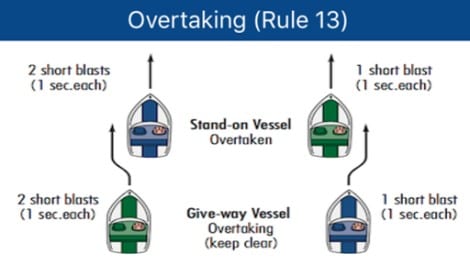 By Bob Currie, Vessel Examiner
By Bob Currie, Vessel Examiner
United States Coast Guard Auxiliary Flotilla 081-06-08
Flotilla 081-06-08 is based at Coast Guard Station Galveston. The Coast Guard Auxiliary is the uniformed civilian component of the US Coast Guard and supports the Coast Guard in nearly all mission areas. The Auxiliary was created by Congress in 1939. For more information, please visit www.cgaux.org.
In the last few columns we have been discussing how following the Maritime Rules of the Road, also known as the Navigation Rules, can help prevent a boating accident. The Navigation Rules book contains both International Rules and Inland Rules, with the International Rule listed first for each rule. There are 38 numbered Navigation Rules, and they are grouped into five major categories and some subcategories:
Part A – General (Rules 1-3)
Part B – Steering and Sailing Rules (Rules 4-19)
- Section I – Conduct of Vessels in Any Condition of Visibility (Rules 4-10)
- Section II – Conduct of Vessels in Sight of One Another (Rules 11-18)
- Section III – Conduct of Vessels in Restricted Visibility (Rule 19)
Part C – Lights and Shapes (Rules 20-31)
Part D – Sound and Light Signals (Rules 32-37)
Part E – Exemptions (Rule 38)
Failure to follow the Rules of the Road was number 7 of the top ten causes of all accidents (fatal and non-fatal) in 2016.
We will start our discussion with Rule 9 – Narrow Channels, and Rule 13 – Overtaking. We have two main narrow channels in our area where extra precautions should be taken: the Houston Ship Channel and the Intracoastal Waterway. Both narrow channels are plied by vessels which must remain inside those narrow channels in order to navigate. Therefore, it becomes the responsibility of the recreational boater to understand how to operate within the vicinity of such vessels.
Rule 9 – Narrow Channels (International Rule)
(a) A vessel proceeding along the course of a narrow channel or fairway shall keep as near to the outer limit of the channel or fairway which lies on her starboard side as is safe and practicable.
(b) A vessel of less than 20 meters in length (65.5 feet) or a sailing vessel shall not impede the passage of a vessel that can safely navigate only within a narrow channel or fairway.
(c) A vessel engaged in fishing shall not impede the passage of any other vessel navigating within a narrow channel or fairway.
(d) A vessel shall not cross a narrow channel or fairway if such crossing impedes the passage of a vessel which can safely navigate within that narrow channel or fairway. The latter vessel shall use the danger signal prescribed in Rule 34 (d) if in doubt as to the intention of the crossing vessel.
(e) (i) In a narrow channel or fairway when overtaking, the power-driven vessel intending to overtake another power-driven vessel shall indicate her intention by sounding the appropriate signal prescribed in Rule 34(c) and take steps to permit safe passing. The power-driven vessel being overtaken, if in agreement, shall sound the same signal and may, if specifically agreed to take steps to permit safe passing. If in doubt she shall sound the danger signal prescribed in Rule 34(d) (Five rapid short blasts).
(e)(ii) This Rule does not relieve the overtaking vessel of her obligation under Rule 13 (Overtaking).
(f) A vessel nearing a bend or an area of narrow channel or fairway where other vessels may be obscured by an intervening obstruction shall navigate with particular alertness and caution and shall sound the appropriate signal prescribe in Rule 34(e).
(g) Any vessel shall, if the circumstances of the case admit, avoid anchoring in a narrow channel.
Discussion: The Inland Rule 9 and International Rule 9 are almost identical, but the Inland Rule 9 adds that within a river, the downbound vessel with a following current has the right-of-way over an upbound vessel. In addition, the Rule 34(c) signals under the International Rule 34 are preceded by two prolonged blasts. Rule 34(c) is demonstrated below.

Rule 13 – Overtaking
(a) Any vessel overtaking any other vessel shall keep out of the way of the vessel being overtaken.
(b) A vessel shall be deemed to be overtaking when coming up with another vessel from a direction more than 22.5 degrees abaft her beam; that is, in such a position with reference to the vessel she is overtaking that at night she would be able to see only the stern light of that vessel but neither of her sidelights.
(c) When a vessel is in any doubt as to whether she is overtaking another, she shall assume that this is the case and act accordingly.
(d) Any subsequent alteration of the bearing between the two vessels shall not make the overtaking vessel a crossing vessel within the meaning of these rules or relieve her of the duty of keeping velar of the overtaken vessel until she is finally past and clear.
Discussion: The takeaways from these two rules are to take extra precautions in narrow channels, to pass with care, and to signal your intentions. If you haven’t already taken a Safe Boating course, consider doing so and you will learn these rules in depth.
For more information on boating safety, please visit the Official Website of the U.S. Coast Guard’s Boating Safety Division at www.uscgboating.org. Questions about the US Coast Guard Auxiliary or our free Vessel Safety Check program may be directed to me at [email protected]. I am available to perform free Vessel Safety Checks, and I will come to your location to perform them. SAFE BOATING!
[3-12-2018]

 Posted in
Posted in 























